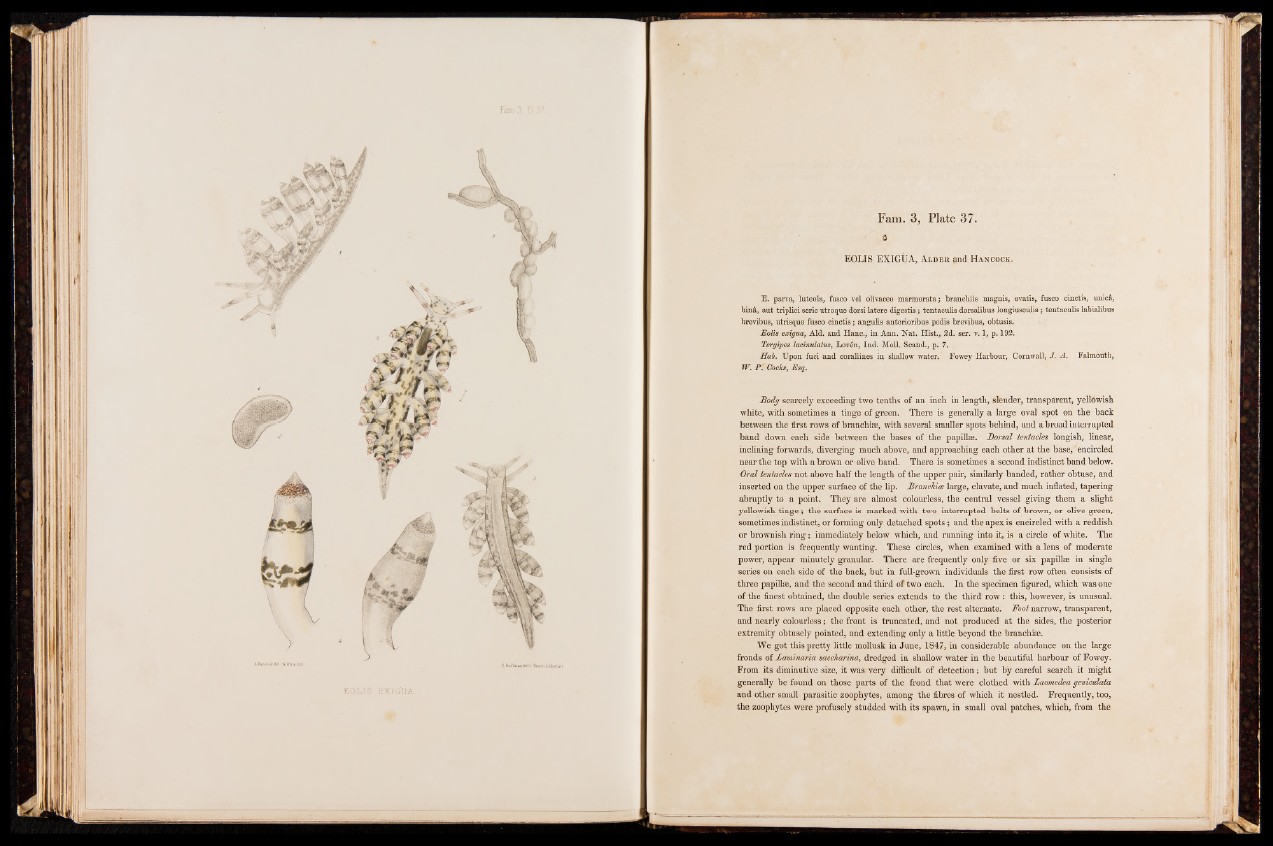
Fam. 3, Plate 37.
EOLIS EXIGUA, Alder and Hancock.
E. parva, luteola, fusco vel olivaceo marmorata; branchiis magnis, ovatis, fusco cinctis, unic&,
bind, aut triplici serie utroque dorsi latere digestis; tentaculis dorsalibus longiusculis \ tentaculis labialibus
hrevibus, utrisque fusco cinctis; angulis anterioribus pedis brevibus, obtusis.
Eolis exigua, Aid. and Hanc., in Ann. Nat. Hist., 2d. ser. v. 1, p. 192.
Tergipes lacinulatus, Loven, Ind. Moll. Scand., p. 7.
Hab. Upon fuci and corallines in shallow water. Fowey Harbour, Cornwall, J. A. Falmouth,
W. p : Cocks, Esq.
Body scarcely exceeding two tenths of an inch in length, slender, transparent, yellowish
white, with sometimes a tinge of green. There is generally a large oval spot on the back
between the first rows of branchiae, with several smaller spots behind, and a broad interrupted
band down each side between the bases of the papillae. Dorsal tentacles longish, linear,
inclining forwards, diverging much above, and approaching each other at the base, ’ encircled
near the top with a brown or olive band. There is sometimes a second indistinct band below.
Oral tentacles not above half the length of the upper pair, similarly banded, rather obtuse, and
inserted on the upper surface of the lip. Branchiae large, clavate, and much inflated, tapering
abruptly to a point. They are almost colourless, the central vessel giving them a slight
yellowish tinge; the surface is marked with two interrupted belts of brown, or olive green,
sometimes indistinct, or forming only detached spots; and the apex is encircled with a reddish
or brownish ring; immediately below which, and running into it, is a circle of white. The
red portion is frequently wanting. These circles, when examined with a lens of moderate
power, appear minutely granular. There are frequently only five or six papillae in single
series on each side of the back, but in full-grown individuals the first row often consists of
three papillae, and the second and third of two each. In the specimen figured, which was one
of the finest obtained, the double series extends to the third row: this, however, is unusual.
The first rows are placed opposite each other, the rest alternate. Foot narrow, transparent,
and nearly colourless; the front is truncated, and not produced at the sides, the posterior
extremity obtusely pointed, and extending only a little beyond the branchiae.
We got this pretty little mollusk in June, 1847, in considerable abundance on the large
fronds of Laminaria saccharina, dredged in shallow water in the beautiful harbour of Fowey.
From its diminutive size, it was very difficult of detection; but by careful search it might
generally be found on those parts of the frond that were clothed with Laomedea yeniculata
and other small parasitic zoophytes, among the fibres of which it nestled. Frequently, too,
the zoophytes were profusely studded with its spawn, in small oval patches, which, from the